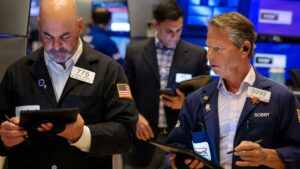Understanding the Recent Surge in Financial ETFs: Insights from Extreme Investor Network
The Financials Select Sector SPDR Fund (XLF) has emerged as a key player during the recent market recovery, marking a notable 15% gain since hitting its intraday low on April 7. As of earlier this week, XLF came remarkably close—just 1%—to its all-time closing high from February 28. This performance amongst US-based ETFs sets XLF apart from its peers, making it the focus of two pivotal questions: Has it surged too quickly? and Can it maintain momentum without rolling over?
Has XLF Gone Too Far, Too Fast?
Rapid increases, such as the 15% rise in just six weeks, are uncommon in the investing landscape. While these bullish trends can ignite investor enthusiasm, they often signal that a slowdown is inevitable. XLF’s recent spike raises critical concerns about whether it can sustain its upward trajectory.
Signs of Market Saturation
Our analysis utilizes technical indicators like the 14-Day Relative Strength Index (RSI) and the Moving Average Convergence Divergence (MACD) to gauge market conditions. As of Monday’s close, XLF’s RSI reached a high of 68, just shy of overbought territory. This figure is the highest since January 25, indicating potential impending weakness. Historically, peaks in the RSI often precede MACD sell signals, hinting that a pullback might be on the horizon.
Bullish Patterns Amidst Potential Setbacks
Although market corrections can often appear alarming, past trends indicate that XLF has demonstrated resilience. It has successfully regrouped before, forming bullish patterns that propelled it higher in earlier bull markets. Current market behaviors suggest that a constructive digestion of the recent gains is necessary. By forming a right shoulder in a potential bullish pattern, XLF could reclaim strength and continue its upward path.
The European Financial Sector’s Outperformance
While XLF shows signs of potential slowdown, the European Financials ETF (EUFN) outpaces it significantly, climbing over 30% since April. With an RSI of 77, EUFN is even more extended than XLF. The strength of EUFN, reflected in its MACD, approaches levels not seen since March—creating a cautionary tale that momentum may soon wane. Investors should remain vigilant about potential reversals here as well.
Investing Strategies for Volatile Markets
The bullish activity in financial stocks is generally a positive signal for both the stock market and the global economy. However, history shows even the most stable sectors can face overheating. A prudent strategy during these times is to consider buying the dip—seizing opportunities during market corrections to capitalize on future growth.
Final Thoughts
At Extreme Investor Network, we believe that understanding the complexities of financial ETFs like XLF and EUFN is crucial for any investor. By leveraging technical indicators and remaining aware of market trends, you can make informed investment decisions. As we continue to monitor these developments, we will provide timely insights that empower you to navigate the evolving financial landscape.
Stay ahead of the market trends, and join us at Extreme Investor Network for more in-depth analysis and unique insights tailored for your investment journey.

